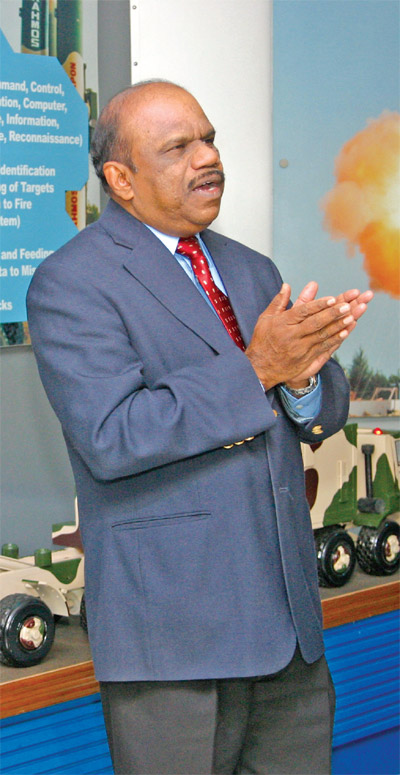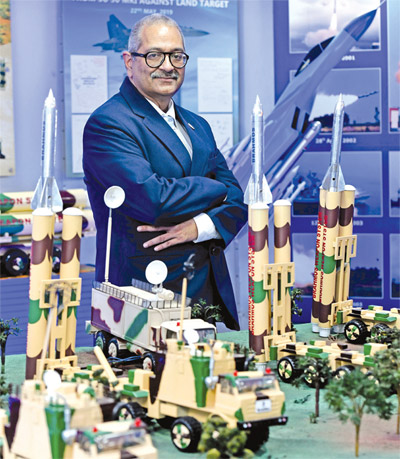What BrahMos Aerospace leaders told FORCE over the years
‘The foundation of the joint venture BrahMos is an example of integration and promotion of jointly developed high technology military products in the world market’
—Dr A. Sivathanu Pillai, Chief Controller R&D, DRDO and CEO & Managing-Director
 An important reason to form a technological joint venture is to share the processes in order to create new and improved knowledge. The realisation of Brahmos supersonic cruise missile is a shining example of this model. India and Russia jointly established Brahmos to design, develop, produce and market a world class supersonic cruise missile system. Brahmos missile is a world class product using the synergy of technological competence and consortium of industries of both partner countries. The Brahmos missile is the fastest operational cruise missile existing in the world today and can be launched from any type of platform land, sea and air to precisely reach the targets either on land or at sea with high lethal effect.
An important reason to form a technological joint venture is to share the processes in order to create new and improved knowledge. The realisation of Brahmos supersonic cruise missile is a shining example of this model. India and Russia jointly established Brahmos to design, develop, produce and market a world class supersonic cruise missile system. Brahmos missile is a world class product using the synergy of technological competence and consortium of industries of both partner countries. The Brahmos missile is the fastest operational cruise missile existing in the world today and can be launched from any type of platform land, sea and air to precisely reach the targets either on land or at sea with high lethal effect.
Sometimes an organisation alone may not have the complete technological skills and resources to design, develop, produce and market the product but if it combines with a complementary partner possessing the requisite skills then it would be possible for the joint venture company so formed to bring the product to the marketplace. The foundation of the joint venture BrahMos is an example of integration and promotion of jointly developed high technology military products in the world market.
In a rapidly transforming world of today, there is a definite need for organisations to work closely with each other to achieve mutual growth. The same applies for nations also because any event happening in a remote corner of the world has far reaching impact on many other nations. No nation can afford to live in isolation. To tackle the varying threat perceptions arising every day, it becomes necessary that nations network with each other to exchange resources and inputs to face the world of tomorrow. A global knowledge platform can be established by linking various governmental and non-governmental organisations with specific focus on defence and strategic issues. Such a global knowledge platform can prove useful in assessing and identifying emerging threats, countering the prevalent threats and ensuring a peaceful world.
(September 2008 in a talk on FORCE 5th Anniversary)
‘We are the first company in the world to integrate such a missile to fighter aircraft’
—Dr Sudhir Kumar Mishra, Director General, DRDO, CEO & Managing-Director
 For the first time in India, we have created a knowledge base in the area of air-launched missiles. You will be able to appreciate the complexity of the task if you see several videos are available on YouTube, which demonstrate how the aircraft gets hit right after separation. BrahMos Aerospace has been lucky in this regard. We were successful in our very first flight test on 22 November 2017. We are the first company in the world to integrate such a missile to fighter aircraft. Usually, long-range and heavy air launched missiles are integrated into bombers but we are the first to integrate a supersonic cruise missile of such range into a fighter aircraft.
For the first time in India, we have created a knowledge base in the area of air-launched missiles. You will be able to appreciate the complexity of the task if you see several videos are available on YouTube, which demonstrate how the aircraft gets hit right after separation. BrahMos Aerospace has been lucky in this regard. We were successful in our very first flight test on 22 November 2017. We are the first company in the world to integrate such a missile to fighter aircraft. Usually, long-range and heavy air launched missiles are integrated into bombers but we are the first to integrate a supersonic cruise missile of such range into a fighter aircraft.
Regarding the Russian contribution, they primarily worked on the missile software and on-board computers which were modified. This was a major development because unlike the other two versions (naval and land), the air version gives the option of air-to-ship and air-to-land. On the hardware side of the missile, there were quite a few major modifications. The suspension points on the aircraft were relocated. The booster was reworked and an additional row of fins were introduced for stability. This was all done by the Russians.
(February 2019)
‘We are taking a pittance of the profit from the USD 375 million Philippine deal. That is because we want to get into the market’
—Chief Executive Officer and Chief Managing Director, Atul Dinkar Rane
 The key things that we are looking for in the BrahMos NG is that it should be smaller, stealthier, faster. That is our motto. The article will be lighter, so that it can be fitted onto more platforms. Right now, on the Su-30, it is under the belly. It can’t be put on the wings because it’s too heavy. We want to make it lighter and put it on the wings. If it is lighter, we can in fact even put it on LCA, MiG-29 or any other platforms. That is for the air force to decide. The LCA would be our main aim, because then we could sell a package. When you buy the Su-30 or Rafale, it comes with its armaments. Why not start selling the LCA with the armament? The moment you make a sale of the LCA, by the way of increasing exports, we can give air-to-air missile Astra and BrahMos-NG (if it is ready by then). It is a way to start.
The key things that we are looking for in the BrahMos NG is that it should be smaller, stealthier, faster. That is our motto. The article will be lighter, so that it can be fitted onto more platforms. Right now, on the Su-30, it is under the belly. It can’t be put on the wings because it’s too heavy. We want to make it lighter and put it on the wings. If it is lighter, we can in fact even put it on LCA, MiG-29 or any other platforms. That is for the air force to decide. The LCA would be our main aim, because then we could sell a package. When you buy the Su-30 or Rafale, it comes with its armaments. Why not start selling the LCA with the armament? The moment you make a sale of the LCA, by the way of increasing exports, we can give air-to-air missile Astra and BrahMos-NG (if it is ready by then). It is a way to start.
Key features of the BrahMos-NG are reduced dimension and weight for widespread usage; advanced next-generation stealth, greater effectiveness against ECCM, higher versatility in underwater combat applications, launch readiness from torpedo tube and vertical orientation. The miniaturised missile could also be deployed in land-attack configuration.
One of the biggest problems we have on exports is the stiff competition we have from the ‘haves’. I use that word for the ones who already have exports. Exports sound great. We are taking a pittance of the profit from the USD 375 million Philippine deal. That is because we want to get into the market. We will think of the profits later on, or even plough back the profit into something else, if at all there is any. Once, the strategy was that even if it is at a bit of loss, at least put the foot in the door. Once your Indian weapon is seen as reliable in terms of after-sales support and maintenance, an ecosystem develops.
(March 2022)

